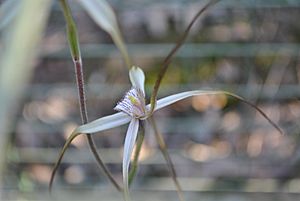Kilsyth South spider-orchid facts for kids
Quick facts for kids Kilsyth South Spider Orchid |
|
|---|---|
 |
|
| Flower of the Kilsyth South Spider Orchid | |
| Conservation status | |
| Scientific classification | |
| Kingdom: | |
| (unranked): | |
| (unranked): | |
| Order: | |
| Family: | |
| Subfamily: |
Orchidoideae
|
| Genus: | |
| Species: |
C. sp. Kilsyth South
|
| Binomial name | |
| Caladenia sp. Kilsyth South G.S.Lorimer
|
|
| Synonyms | |
|
|
The Caladenia sp. Kilsyth South, also known as the Kilsyth South spider orchid, is a super rare ground orchid. It is mostly found only in Kilsyth South, a suburb near Melbourne, Victoria, Australia. Some reports also suggest it might grow in Shenzhen, China, but it is incredibly rare in Australia.
This special flower was first discovered in 1991. A local expert on plants, Dr. Graeme Lorimer, was the one who officially described it.
Contents
What Makes This Orchid Special?
The Kilsyth South spider orchid grows on the ground and can reach up to 35 centimeters (about 14 inches) tall. Each plant usually has one or two large, creamy white flowers.
Flower's Unique Look
The flower's petals and sepals, called tepals, can grow up to 70 millimeters (about 2.7 inches) long. These long, thin tepals make the flower look a lot like a spider, which is how it got its name! The tips of these tepals are reddish-brown and have tiny bumps, like glands.
The labellum, which is the special lip-like petal of the orchid, also has reddish bumps called calli and small tooth-like edges. These features help attract insects for pollination.
Why This Orchid Needs Our Help
This orchid is one of the rarest plants in the world. When it was first found, only 23 plants were ever seen. Sadly, today, there is only one adult plant left that can flower in the wild.
Saving the Spider Orchid
Because it is so rare, people are working hard to save it. The Royal Botanic Gardens, Melbourne is trying to grow more of these orchids from their seeds. This project, called a "propagation trial," aims to increase the number of plants and help this amazing orchid survive for future generations.




